Yangcheng and the Inn of Eight Happinesses |
(Note: I often receive requests to use these photos in giving talks, lectures, etc. I am happy for people to use them provided that acknowledgement of their source, and if possible a link to this page, is given.)
Some years ago, I'm not sure when, possibly in the late 90s, an Australian friend gave me a book titled The Small Woman by Alan Burgess. It was an old 1959 reprint of a book originally published in 1957 concerning the life of Gladys Aylward, a London woman who lived as a missionary in Shanxi province during the 1930s and 1940s.
The story is an inspiring one. After working as a housemaid in London for a number of years, Gladys spent her life savings on a ticket to China in order to become a missionary. After a perilous journey across the TransSiberian, she arrived in China (after a detour through Japan) and made her way to Yangcheng (阳城 yángchéng), a town in the mountains of Shanxi province. There she joined an older missionary, Jeannie Lawson, to set up a hostel for muleteers with the idea of entertaining them with Bible stories and winning converts to Christianity. The inn was auspiciously called the Inn of Eight Happinesses (八福客栈 bāfú kèzhàn in Chinese), based on eight virtues: Love, Virtue, Gentleness, Tolerance, Loyalty, Truth, Beauty, and Devotion. Over the next few years, this inn established itself on the mule routes that ran through Yangcheng from east to west, and Gladys had some amazing (if at times amazingly grim) experiences before she left China in 1948. This included becoming friends with the local Mandarin, working as a foot-binding inspector (ensuring that the ban on the practice was adhered to), helping put down a prison riot, adopting a number of orphan children (in one case thwarting the kidnapping of one of her wards), and witnessing the cruelty of Chinese life (bandits and executions) and the great brutality of the Japanese invasion before leading a large band of children hundreds of miles out of the mountains to safety.
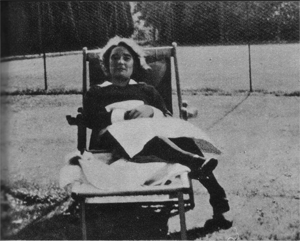
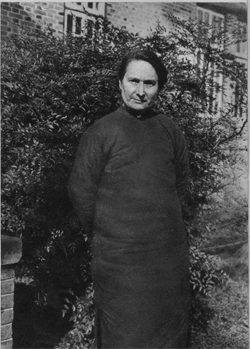
Gladys in London as a parlourmaid, and many years later a veteran of missionary work about to leave China. (From The Small Woman by Alan Burgess)
Burgess tells the story of Ài Wěidé (艾伟德), as she was known in Chinese, with a great sense of wonderment, accompanied by a certain amount of exaggeration and, it might be said, at times a certain gentle mocking tone at his subject's straight-laced values. But the story itself is strong enough to carry any imperfections in Burgess's telling. Indeed, the book soon made it to Hollywood as the movie The Inn of the Sixth Happiness, although Gladys was unhappy with the many liberties that were taken with the plot and characters. She herself later published her own version of her experiences in China as Gladys Aylward: The Little Woman.
A few years after I read Burgess's book, I remained so intrigued by this intrepid woman's adventures in the backblocks of Shanxi province that I decided, on a whim, to visit the town of Yangcheng over the May Day break in 2006. Hopefully I would see what this mysterious town looked like and perhaps also be able to find the Inn of Eight Happinesses.
It is now seven long years since that visit, and in 2013 I am finally posting some of the photos I took at the time. While my memories are getting hazy, the photos have not. Read on to see what I managed to find.
The Town of Yangcheng
In The Small Woman, Gladys's journey from Tsehchow (泽洲 zézhōu) is described as being nearly a two-day trek inside a litter perched on a mule, much of it along 'narrow paths hacked from the mountainside'. Nowadays it's a quick bus trip up a broad road from Jincheng (晋城 jìnchéng), to which Yangcheng belongs administratively.
Burgess describes Yangcheng thus:
Yangcheng has sat there on its mountain saddle, a tiny crock of Confucian civilisation astride the ancient track between Hornan [Henan] and Horbay [Hebei], longer than man can remember, or history has recorded. The mule-track passes in through the East Gate and out through the West. On three sides the country falls away steeply, but there are inns and cave dwellings on the slopes. On the south side it falls sheerly, thousands of feet to the wild valley below, and standing on the city wall one can look out towards the distant mountain ranges.
Burgess appears to have engaged in a little romanticising here. My first photo is taken from a hill to the east of Yangcheng, the rough location of which is shown by the black circle on this Google Earth snapshot (map sampled in May 2013).
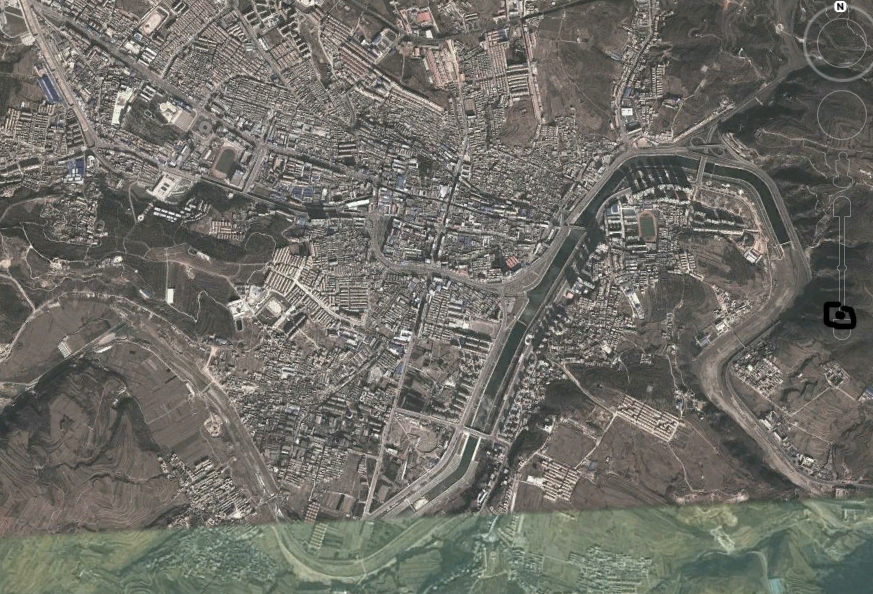
Even from the Google Earth photo it's clear that there is no drop of thousands of feet into the wild valley below, and unless the processes of flattening and erosion are proceeding more rapidly here than the rest of the world, there wasn't a drop of this magnitude in Gladys Aylward's time, either. Despite the smog and the less than comprehensive angle, my photo from the hilltop also fails to show any precipitate drop.
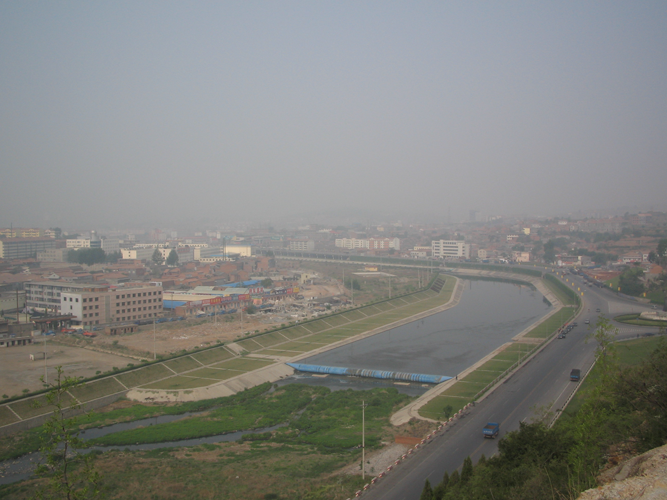
Overlooking the town of Yangcheng
Yangchang has clearly changed a lot since Gladys Aylward's days. The core of the town is still the old quarter, but the built up area has expanded considerably, especially to the west.
However, despite these considerable changes, a closeup of the central part of the town still reveals the outline of what was there in the 1930s and 1940s when Gladys lived here.
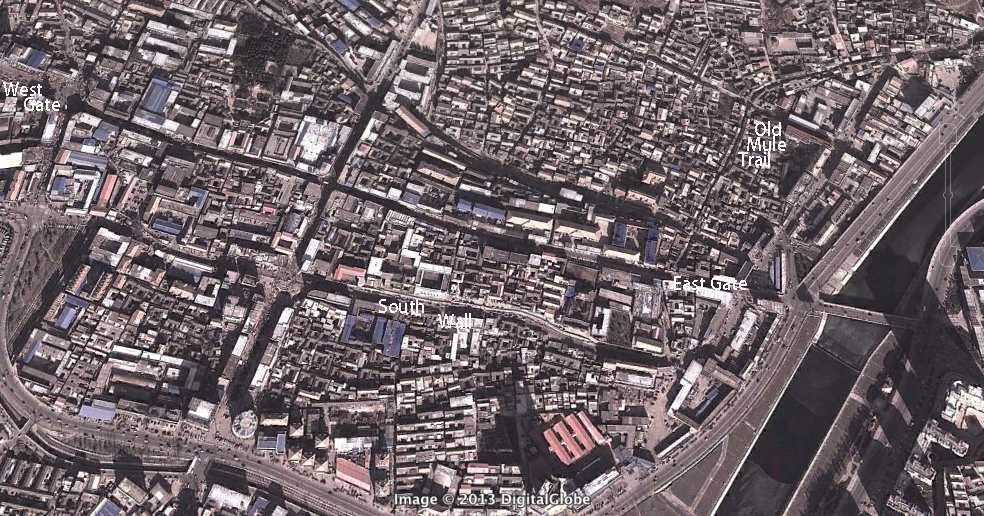
Closeup of the central part of town
The mule track that Gladys first entered Yancheng by is still visible, winding its way from the northeast corner up to the site of the East Gate. It is a very narrow street compared to the broad roads that have been built since. The photos below show the old road very close to the East Gate. What I was told are parts of the old paving are still visible.
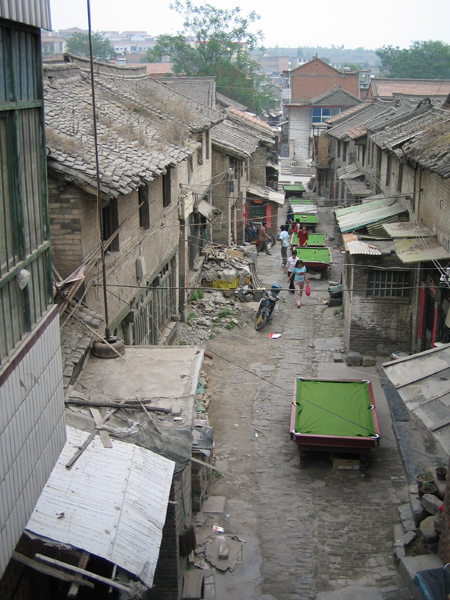
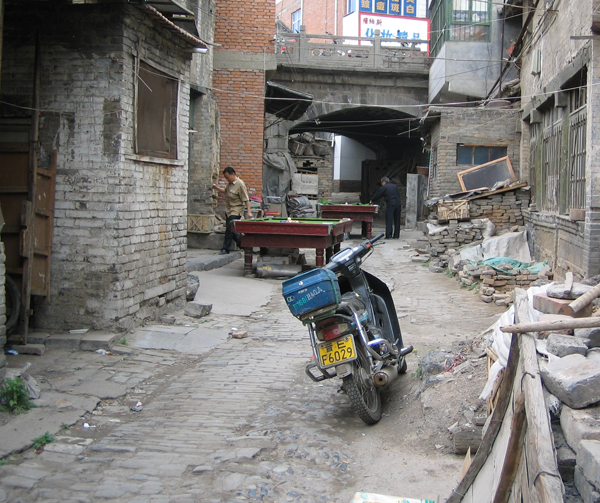
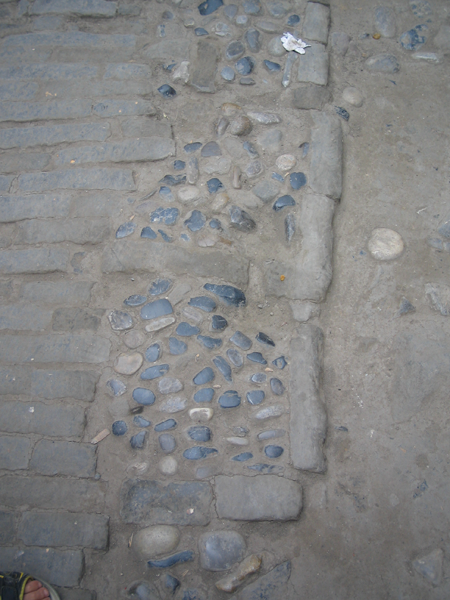
The old road into town, along which mule traffic used to pass. The photo shows the same stretch of street, looking from opposite directions. The motorbike in the street is the same bike in both photos. The photo at bottom shows what is said to be the old paving.
The East Gate itself is no longer there, and the location is less clear than it might be because the road leading up to the gate is elevated -- it is the bridge visible in the second picture above. The photo below is a view of the road leading up to the East Gate.
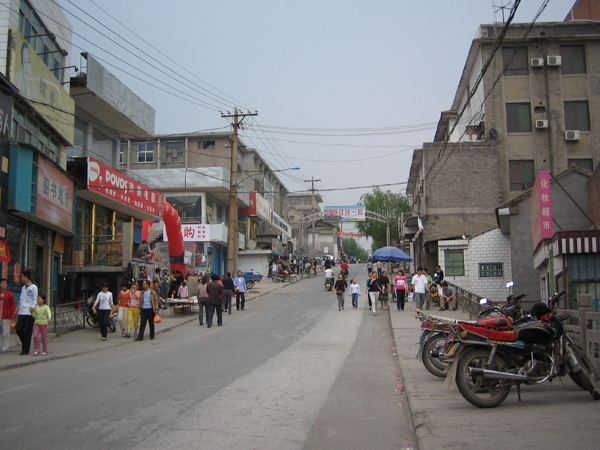
The East Gate
From the East Gate the main street of the town leads directly across to the West Gate, whose location is still visible on the map as the place where the street suddenly widens into a broad avenue leading away to the west.
The West Gate of Yangcheng in Gladys's time is shown in the picture below. The hornblower blowing his horn and the smirking boy near the wall tell of a photo staged for the cameraman. While the photo doesn't show a great deal, it is enough to let us know that the West Gate was a gate in the wall surrounding Yangcheng.
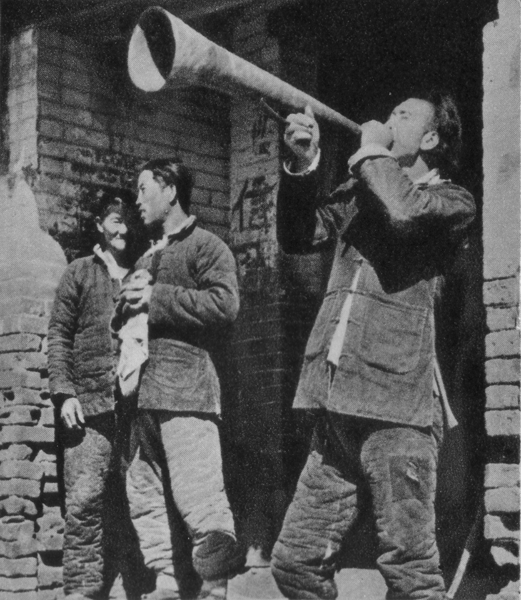
The West Gate in Gladys's time (from The Small Woman by Alan Burgess)
The location of the West Gate in 2006 is captured in this photo, the point where the narrow main street broadens into a wide road.
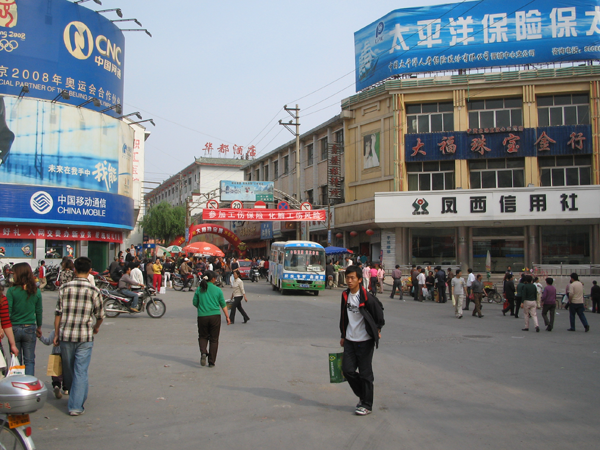
This is the West Gate as it was in 2006
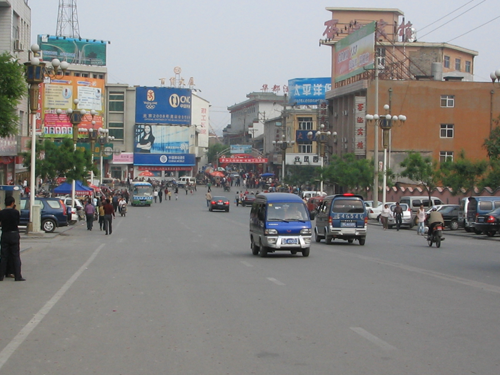
A view from further out
Outside the gate, the whole area to the west of the old town has been redeveloped into new housing and parks.
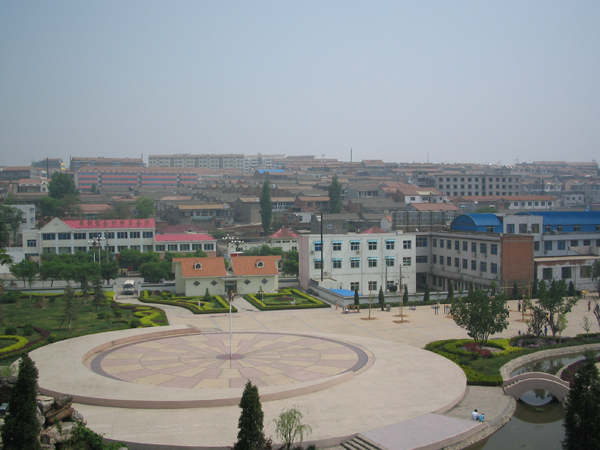
Just part of a very large district of new housing west of the West Gate, seen from a park
While West Gate no longer has its wall, the southern wall appears to be intact. On the map, it is visible as a line connecting the East Gate to the West. During the time of the Japanese Invasion, Gladys came back to the West Gate after the Japanese had been through the town, and, according to the book, 'skirted the wall, clambering round the narrow apron of rock which dropped sheerly to the valley below, on the yamen side of the city, until she reached the East Gate.' Below is the old south wall that Gladys must have crept along as she made her way to the East Gate and the Inn of the Eight Happinesses in order to claim her title deeds.
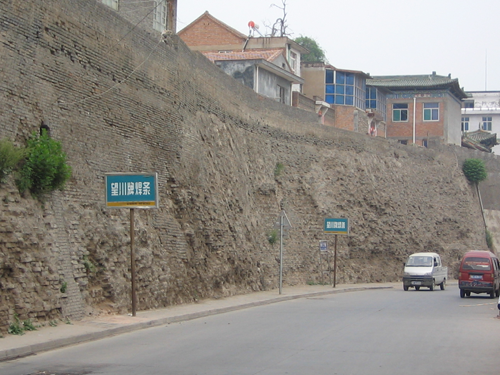
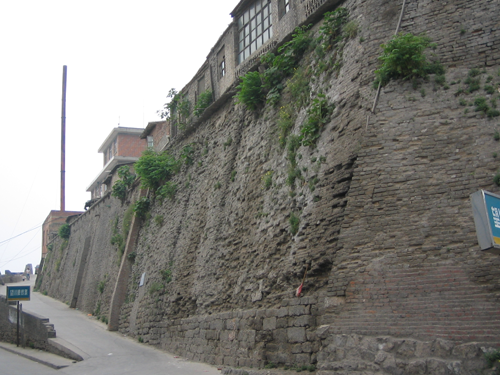
Two sections of the still extant south wall
That is a quick look at a couple of the surviving parts of the town. The question is, however, whether the Inn of the Eight Happinesses itself still exists. That can be seen on the next page. 